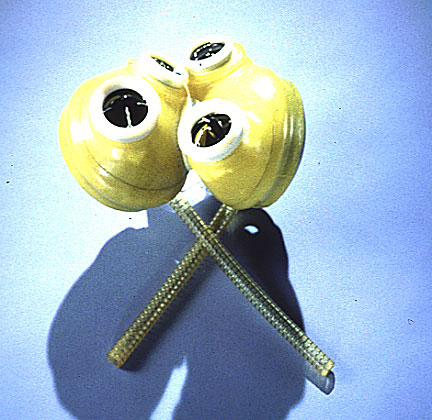Have a heart!
The remarkable Blue Heart Diamond was found at the Premier Mine, South Africa in 1908. This 30.62 carat heart-shaped, brilliant cut blue diamond was faceted by French jeweler Atanik Eknayan of Paris in 1909-1910 from a 100.5 carat piece of rough. The stone was purchased by the French jeweler, Pierre Cartier in 1910. Cartier then sold it to a Mrs. Unzue of Argentina in a lily-of-the-valley brooch in 1911. It was next acquired by Van Cleef & Arpels in 1953 and sold to a European family in the form of a pendant. In 1959, it was purchased by Harry Winston who mounted it in its present platinum ring setting, surrounded by 25 round brilliant cut colorless diamonds with a total weight of 1.63 carats. The Blue Heart Diamond is approximately 2/3 the size of the Hope Diamond, but its heart-shaped brilliant cut and lively blue color have made it one of the collections most popular gems.
This Purple Heart was awarded posthumously to Edward C. Morse who was killed aboard the USS Arizona on 7 December 1941. The Purple Heart is the oldest military decoration in the world in present use. It is the first American award made available to the common soldier. General George Washington created it as a Badge of Military Merit. The Purple Heart is awarded to members of the armed forces of the U.S. who are wounded at the hands of the enemy. It is awarded posthumously to the next of kin in the name of those who are killed in action or die of wounds received in action. It is specifically a combat decoration.
The International Sweethearts of Rhythm
The nation’s first integrated, female big band began as students in 1937 at the Piney Woods School in Rankin County, Miss. The Piney Woods School, founded in 1909 by Laurence Clifton Jones, began on a log under a cedar tree. Students were former slaves and their descendants.
The International Sweethearts of Rhythm band members were students, 14 years and older, who paid for their education by performing as a jazz band to help promote and sustain the financially struggling school. The band confronted dual biases of gender and race and excelled during a period in history when the majority of African Americans lived in the South under Jim Crow laws.
The Heart Peaks shield volcano, located in northwest British Columbia, rises above the Heart Peaks Plateau, which is sculpted on all sides by tributaries of the Inklin River. The colorful bright green and pink, steep-sided lava domes of the Heart Peaks Formation are formed of porphyritic rhyolitic and minor trachytic rocks. The Heart Peaks volcano is monitored by the Global Volcanism Project in the Department of Mineral Sciences at the Natural History Museum. The GVP seeks better understanding of all volcanoes through documenting their eruptions–small as well as large–during the last 10,000 years. GVP also plays a central role in the rapid dissemination of information about on-going volcanic activity on Earth by publishing eruption reports from local observers in the monthly Bulletin of the Global Volcanism Network.
Edward Teach (c. 1680 – 22 November 1718), better known as Blackbeard, was a notorious English pirate who operated around the West Indies and the eastern coast of the American colonies. A shrewd and calculating leader, Teach spurned the use of force, relying instead on his fearsome image to elicit the response he desired from those he robbed. Designed to intimidate, Blackbeard’s flag showed a skeleton piercing a heart and offering a toast to the devil. He was romanticized after his death and became the inspiration for a number of pirate-themed works of fiction across a range of genres. Blackbeard died in battle with Lieutenant Robert Maynard of HMS Pearl in 1718.
Dr. Jack G. Copeland implanted this Jarvik-7 heart in Michael Drummond on August 29, 1985. Drummond lived with the Jarvik-7 for a week before an organ transplant. It was the first authorized use of an artificial heart as a bridge to organ transplantation. Dr. Robert K. Jarvik developed the heart during the late 1970s, working with many other researchers. It consists of two ventricles (the heart’s lower chambers) with air chambers and six titanium valves. It attaches to the patient’s natural auricles (the heart’s upper chambers).
In 1956, 26-year old Alfred Wertheimer was asked to photograph a rising 21-year-old-star named Elvis Presley. When Presley walked on stage that year, he altered the beat of everyday life. The world changed. Wertheimer captured the singer’s transit to superstardom and the cultural transformation he helped launch. “Elvis at 21” offers viewers an intimate look at the public and private life of one of the world’s most famous figures, and documents classic American life—from the diners to the train stops—in 1956.
Posted: 14 February 2013










